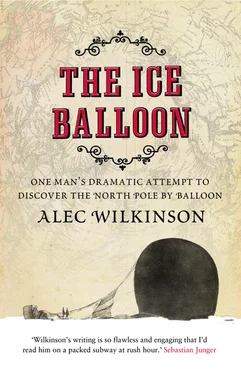One man’s dramatic attempt to
discover the North Pole by balloon

For Sara Barrett
and
Sam Wilkinson
Cover
Title Page
Dedication
1
In August of 1930, a Norwegian sloop, the Bratvaag, sailing…
2
Except for the bottom of the sea or the center…
3
Why did they go, then, this parade of fanatics heading…
4
Flying over the pole in a balloon appears to have…
5
Among the first in the audience to rise and respond…
6
The first mariners to go toward the North had no…
7
After Andrée’s speech in London, a lot of explorers and…
8
Sailing to America, Andrée had had two acquaintances, his cabin…
9
Historically the Arctic was congenial to opposites. For some of…
10
Soon after Andrée got to Philadelphia, he “looked up the…
11
Andrée exemplified a conceit that outlived him—the belief, then nascent,…
12
By the time Andrée announced his plan to leave for…
13
Once Andrée was grown, the only woman for whom he…
14
In 1875 an Arctic explorer named Karl Weyprecht, who was…
15
The first balloon plans patented were patented in Lisbon in…
16
While Andrée was in Spitsbergen at the Swedish station, making…
17
No one got along any better during the second winter.
18
For thirteen days they drifted among pack ice, “suffering horribly…
19
On the first of June, Kislingbury sat up in his…
20
Once the men were aboard, the party retrieved the dead…
21
Andrée didn’t ride in a balloon until he was thirty-eight,…
22
Leaving the ground on its fourth flight, in February of…
23
After giving his speech in Stockholm, Andrée went back to…
24
The notion that natives of the Arctic had a hundred…
25
There is more than one North Pole. Andrée’s destination, the…
26
Andrée was to be accompanied to the pole by Nils…
27
The Jeannette, the ship that Greely had been supposed to…
28
The Fram left Norway with thirteen men in June of…
29
Nansen and Andrée were inspired by visionary theories they were…
30
The days passed half-idly with tasks and diversions. One night…
31
In November of 1894, on a walk in the evening…
32
On July 24, for the first time in two years,…
33
Nansen asked how things were at home, and Jackson said…
34
When Andrée, Strindberg, and Eckholm left Göteborg for Dane’s Island…
35
On August 16, Andrée sent a telegram announcing that the…
36
Over the winter Nansen and Andrée exchanged letters. Nansen felt…
37
At the end of October 1896 Andrée wrote to Alfred…
38
Over the winter Alfred Nobel died, unsettling Andrée. Then, shortly…
39
Arriving at Dane’s Island in a bay filled with pack…
40
On July 6, during a storm, the wind blew heavily…
41
Around three in the morning on July 11, the wind…
42
They left at two-thirty in the afternoon. First the hawsers…
43
Andrée had predicted the speed of the Arctic wind from…
44
A few days after the launch Svedenborg, the alternate, visited…
45
Toward the end of July the Chicago Chronicle wrote, “Has…
46
Oscar Strindberg wrote in a letter, “And so one has…
47
In 1898 word reached Sweden from Russia that Andrée had…
48
Andrée began to travel like a shade through the pages…
49
In October men sent to look for Andrée in Alaska…
50
What else? Two of Andrée’s sisters, interviewed in Gränna, said…
51
The experience that Andrée might be having on the ice…
52
On the following day the men’s faces were swollen, but…
53
The Bratvaag was hired during the summer of 1930 to…
54
The following day, August 8, the Bratvaag met the Ternigen,…
55
In Tromsø a black pall was brought from the cathedral…
56
A number of journalists had gone looking for the Bratvaag.
57
Early in the afternoon of October 5, 1930, escorted by…
58
The Isbjorn had been able to stay at White Island…
59
That evening the concussions against the ice made Strindberg seasick.
60
Andrée landed the balloon so expertly that none of the…
61
On the evening of July 22, they began walking southeast…
62
On the morning of the thirty-first, they got under way…
63
In the Proceedings of the Royal Geographical Society for August…
64
Turning toward the Seven Islands on the fourth, they crossed…
65
On the thirtieth they started walking at five in the…
66
“Since I wrote last in my diary much has changed,…
67
Andrée decided to cross in the boat to another floe,…
68
The following day Andrée shot two seals. “I cannot describe…
69
Explorers kept diaries mainly to publish them. Even when they…
70
Who finally discovered the pole is disputed. Frederick Cook, an…
71
One winter I went with a friend to their grave,…
72
After I got back from Sweden, I wondered what the…
Acknowledgments
Bibliography
A Note About the Author
Other Books by Alec Wilkinson
Copyright
About the Publisher
In August of 1930, a Norwegian sloop, the Bratvaag, sailing in the Arctic Ocean, stopped at a remote island called White Island. The Bratvaag was partly on a scientific mission, led by a geologist named Dr. Gunnar Horn, and partly out sealing. On the second day, the sealers followed some walruses around a point of land. A few hours later, they returned with a book, which was sodden and heavy, and had its pages stuck together. The book was a diary, and on the first page someone had written in pencil, “The Sledge Journey, 1897.”
Horn rode to shore with the Bratvaag’s captain, who said that two sealers dressing walruses had grown thirsty and gone looking for water. By a stream, Horn wrote, they found “an aluminum lid, which they picked up with astonishment,” since White Island was so isolated that almost no one had ever been there. Continuing, they saw something dark protruding from a snow-drift—an edge of a canvas boat. The boat was filled with ice, but within it could be seen a number of books, two shotguns, some clothes and aluminum boxes, a brass boathook, and a surveyor’s tool called a theodolite. Several of the objects had been stamped with the phrase “Andrée’s Pol. Exp. 1896.” Near the boat was a body. It was leaning against a rock, with its legs extended, and it was frozen. On its feet were boots, partly covered by snow. Very little but bones remained of the torso and arms. The head was missing, and clothes were scattered around, leading Horn to conclude that bears had disturbed the remains.
He and the others carefully opened the jacket the corpse was wearing, and when they saw a large monogram A they knew whom they were looking at—S. A. Andrée, the Swede who, thirty-three years earlier, on July 11, 1897, had ascended with two companions in a hydrogen balloon to discover the North Pole.
Before the twentieth century, more than a thousand people tried to reach the pole, and according to an accounting made by an English journalist in the 1930s, at least 751 of them died. Only Andrée used a balloon. He had left on a blustery afternoon from Dane’s Island, in the Spitsbergen archipelago, six hundred miles from the pole. It took an hour for the balloon, which was a hundred feet tall, to disappear from the view of the people who were watching from the shore—carpenters, technicians, members of the Swedish navy who had assisted in the weeks leading up to the launch.
Читать дальше













